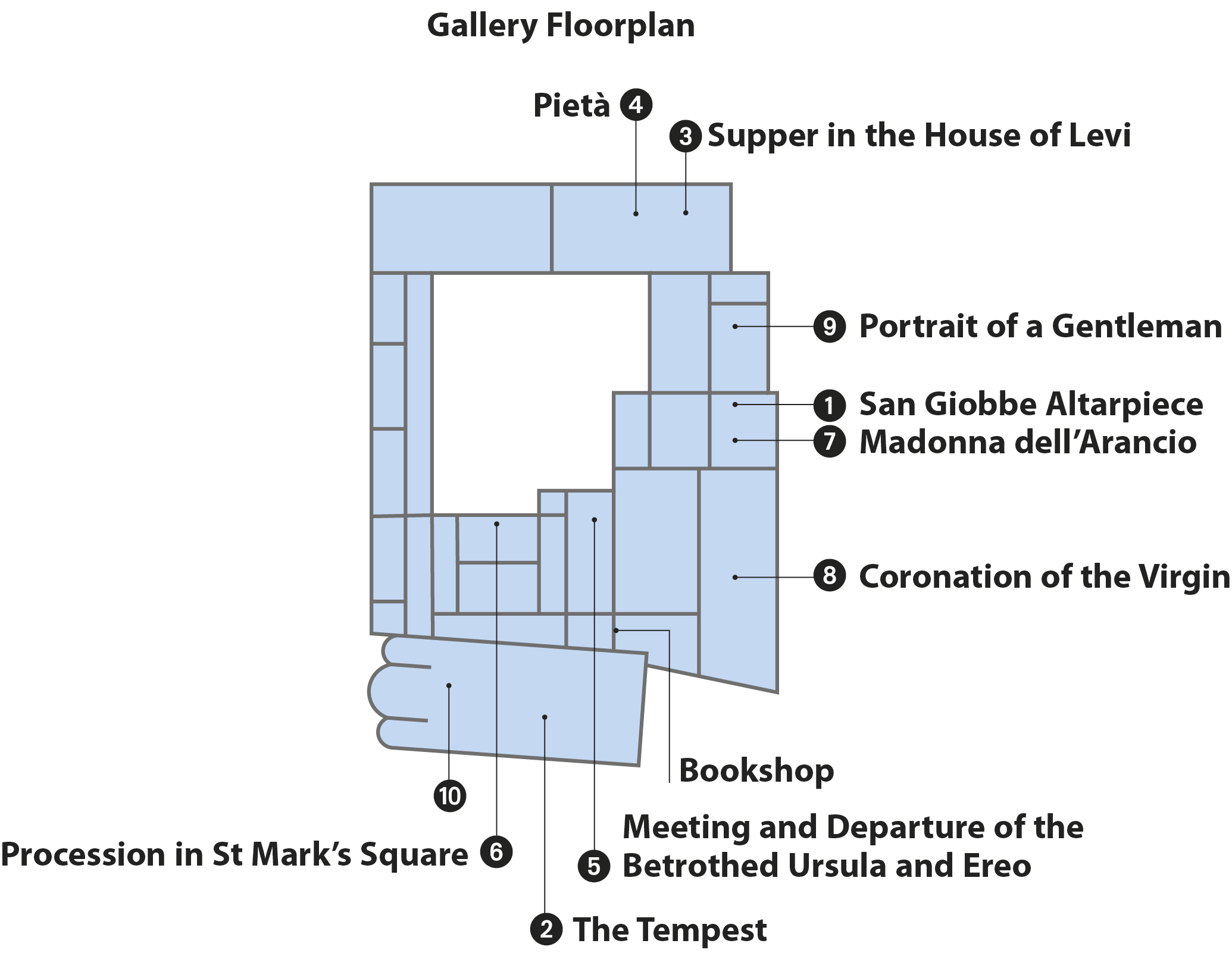
ACCADEMIA GALLERIES
A dazzling collection of masterpieces spanning the full development of Venetian art from Byzantine to Renaissance, Baroque and Rococo, the Gallerie dell’Accademia is Venice’s equivalent of the Uffizi in Florence. Giovanni Battista Piazzetta started the collection in 1750 to serve as models for the art school; in 1807 it was boosted by Napoleon with the addition of works from suppressed churches. The same year the collection moved to its present premises, occupying three former religious establishments: the 12th–15th-century Scuola Grande di Santa Maria della Carità and its adjoining church, and a 12th-century monastery remodelled by Palladio in the 1500s. In the 1940s, architect Carlo Scarpa modernized the interior spaces.
NEED TO KNOW
![]() Campo della Carità, Dorsoduro 1050 • 041 522 22 47 • www.gallerieaccademia.it • Open 8:15am–7:15pm daily (to 2pm Mon; last admission 45 minutes before closing); closed 1 Jan, 1 May, 25 Dec • Adm €12
Campo della Carità, Dorsoduro 1050 • 041 522 22 47 • www.gallerieaccademia.it • Open 8:15am–7:15pm daily (to 2pm Mon; last admission 45 minutes before closing); closed 1 Jan, 1 May, 25 Dec • Adm €12
- The galleries are currently undergoing extensive expansion, so the floorplan may differ from that shown here until the work is completed in mid-2019.
Gallery Guide
The vast gallery is organized in chronological order for the most part and the rooms, labelled with roman numerals, are equipped with explanatory cards in English. The Quadreria corridor is filled with masterpieces.

1. San Giobbe Altarpiece
Giovanni Bellini’s inspirational altarpiece (Room 2) was painted in 1487 for the Church of San Giobbe. It is regarded as one of the finest examples of Sacra Conversazione, which was central to 15th-century Venetian art. The presence of St Sebastian and St Giobbe beside the Virgin suggests the aftermath of plague, while angel musicians pay homage to San Giobbe, patron saint of music.

15th-century altarpiece by Giovanni Bellini
2. The Tempest
This enigmatic 1506 portrayal of a woman suckling her child is by Giorgione (Room 23). The overall impression is of the figures and the dream-like, stormy landscape blended into one whole.

Giorgione’s The Tempest
3. Supper in the House of Levi
The forceful canvas by Veronese (1573) occupies an entire wall of Room 10 and caused controversy in its time. The church authorities, who commissioned it as “The Last Supper”, were angered by the inclusion of “dogs, buffoons, drunken Germans, dwarfs and other such absurdities” – so Veronese changed the title.
4. Pietà
Titian’s last work (1576) is unfinished but it is also considered his best (Room 10), imbued as it is with golden light and a piercing sense of anguish.
5. Meeting and Departure of the Betrothed Ursula and Ereo
Part of Carpaccio’s magnificent narrative cycle (1495) about a Breton princess and an English prince can be seen in Room 21.
6. Procession in St Mark’s Square
Part of Gentile Bellini’s spectacular cycle (1496) of the St Mark’s Day procession in 1444 can be seen in Room 20.

Gentile Bellini’s Procession in St Mark’s Square
7. Madonna dell’Arancio
This exquisite work (1496–8) by Cima da Conegliano, painted for a Murano Franciscan church, is enlivened with partridges and plant life (Room 2).
8. Coronation of the Virgin
This resplendent polyptych (1350) by Venice’s leading 14th-century artist, Paolo Veneziano, is the first work in Room 1. Flanking the stunning Byzantine-inspired central piece are events depicted from the life of Christ.
9. Portrait of a Gentleman
Lorenzo Lotto’s sombre image of a melancholic man of means in his study (1528) may be a self-portrait (Room 7). Lotto was known for works of psychological insight.

Lorenzo Lotto’s Portrait of a Gentleman
10. Lion of St Mark with Saints John the Baptist, John the Evangelist, Mary Magdalene and Jerome
This marvellous canvas (in Room 23) by Cima di Conegliano depicts a winged lion flanked by four saints.